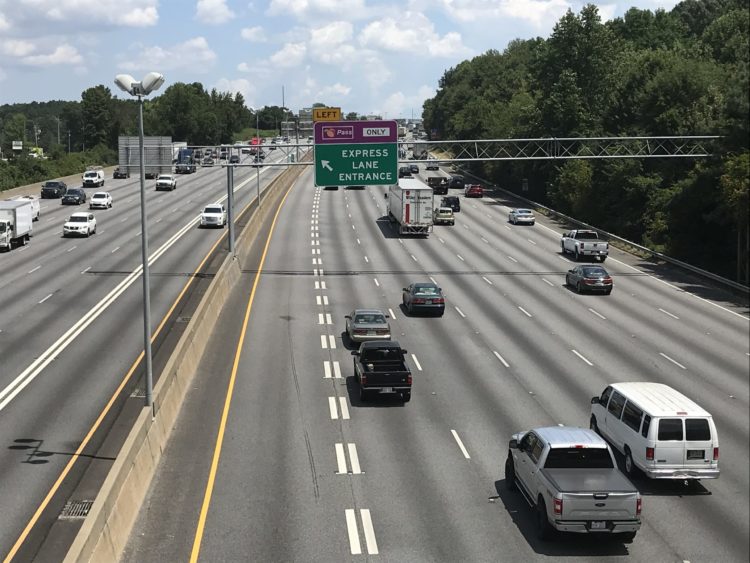Play all audios:
_Editor’s note: This story was updated Thursday night with the 40 percent service reductions discussed Thursday by the CEO of New York City’s MTA._ By David Pendered MARTA’s planned service
expansion in Downtown Atlanta and, possibly, into Gwinnett County comes as MARTA’s finances have received positive credit reviews and a budget that could afford to stretch federal
pandemic-related funds into future years. In terms of MARTA’s planned and potential expansion: * MARTA expects to meet a Sept. 30 deadline for submissions to the Federal Transit
Administration regarding the planned bus rapid transit service to connect Summerhill with the Five Points Station, MARTA CEO Jeff Parker said Wednesday during a virtual meeting of the
Atlanta City Council’s Transportation Committee. * MARTA could be called upon to establish a heavy rail line into Gwinnett County, from the Doraville Station as far north as Gwinnett Place.
This project is contingent upon passage of the Nov. 3 transit referendum that would establish a 30-year, 1 percent sales tax for transit. MARTA is the region’s designated operator of heavy
rail transit. These new horizons arise as MARTA appears to stand on solid financial footing, at least in the context of the global recession triggered by the response to COVID-19. Moody’s
Investors Service provided an optimistic credit opinion on March 23. This was at the start of the COVID-19 economic collapse, before MARTA’s revenue outlook diminished as the two main
sources of revenue have decreased – passenger fares and sales tax revenues. Nonetheless, MARTA’s board was able to adopt a $1.2 billlion budget in June that did not entail layoffs or fare
hikes, according to a statement. In contrast, the head of the MTA in New York said Thursday service cutbacks of 40 percent are in the future if Congress doesn’t provide $12 billion in
pandemic relief funding. The MTA announced the cuts Wednesday and MTA CEO Patrick J. Foye described them in a transcript of an interview on WCBS Newsradio 880: * “To be clear, no one at the
MTA wants to take these steps, which include up to a 40% reduction on service on subways, buses, and Staten Island Railway, and up to a 50% reduction in service on Long Island Rail Road and
Metro-North. And the combined reduction in headcount layoffs, of 8,400 of our colleagues. * “Right now, the state government is broke. Actually, every state in the country is broke. New York
City is broke and the only entity that has the resources to provide the MTA $12 billion is the federal government. The federal government did provide $3.9 billion in March in the CARES Act
and we’re incredibly grateful for that. We exhausted that funding in July and we had to demonstrate to the United States Department of Transportation that we had revenue declines to get
those funds.” Moody’s released its report on MARTA at the start of the COVID-19 economic collapse, before MARTA’s revenue outlook diminished as the two main sources of revenue have decreased
– passenger fares and sales tax revenues. Transit systems across the nation experienced similar collapses and shared in relief funding. The current request is for $32 billion in transit
funding, submitted by the American Public Transportation Assoc. Nonetheless, MARTA entered the downturn with ample reserves, Moody’s analysts observed of two key indicators of any business
enterprise, as well as the impact of sales taxes collected in Clayton County since voters agreed to fund MARTA: “Debt service coverage * “Pledged revenue covers debt service amply and MARTA
anticipates continually improving coverage, backed by increasing revenue and declining debt service. Nonetheless, coverage may decline or grow at a slower rate owing to new issuances and a
tempering of revenue growth over the short-run.” “Liquidity * “MARTA has built up healthy liquidity through several years of operating surpluses. At the end of fiscal 2019, MARTA had $22
million of cash and an additional $356 million of short-term high-grade investments. These two sources of liquidity sum to more than 260 days cash on hand.” Clayton County * “Clayton
County’s sales tax took effect in April 2015, having a small impact on fiscal 2015 figures and a large impact on fiscal 2016 figures.” These figures do not include the additional 0.5 percent
sales tax Atlanta voters approved in 2016. Proceeds of the 0.5 percent tax levied in Atlanta are not pledged to MARTA, as are the 1 percent sales taxes collected in Atlanta and the counties
of Clayton, DeKalb and Fulton, according to the report by Moody’s. The budget approved in June by MARTA’s board of directors provides another view of the agency’s financial position – the
use of federal funds Congress provided to the nation’s transit agencies. MARTA reported an allocation of $298.6 million in funding from the federal CARES Act. The board reported it
anticipates using that money for three years, and possibly longer. This is the breakdown in use of funds: * Fiscal year 2020: $83 million; * Fiscal Year 2021: $150 million; * Fiscal Year
2022: $65.6 million. * Surplus: Any surplus of funds in a given year will be placed in a sales tax reserve fund. MARTA reported the reserves could help offset potential deficits through
2025. _RELATED POSTS_

